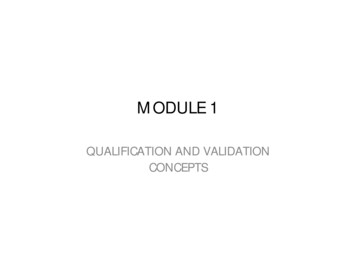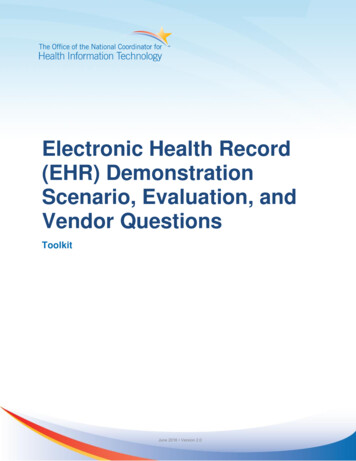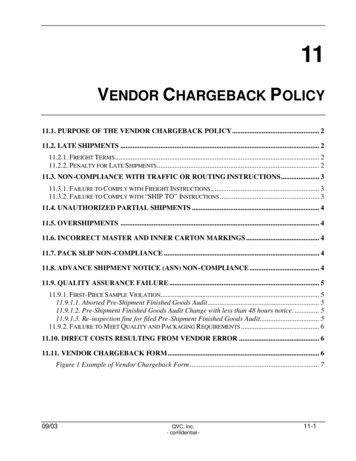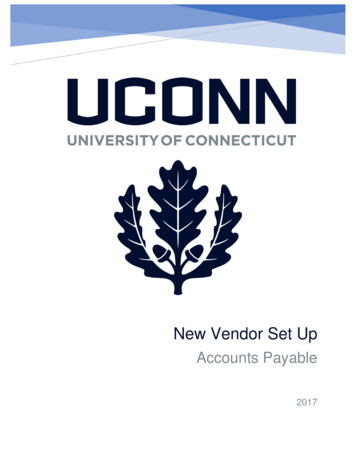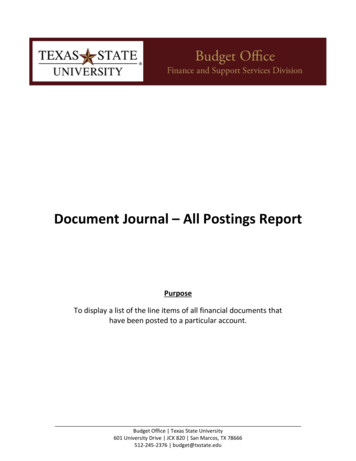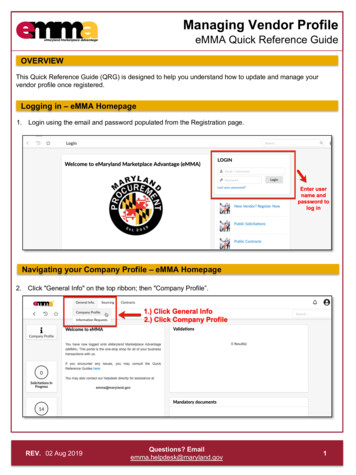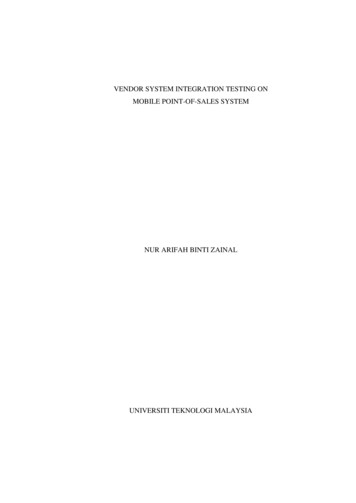
Transcription
VENDOR SYSTEM INTEGRATION TESTING ONMOBILE POINT-OF-SALES SYSTEMNUR ARIFAH BINTI ZAINALUNIVERSITI TEKNOLOGI MALAYSIA
VENDOR SYSTEM INTEGRATION TESTING ONMOBILE POINT-OF-SALES SYSTEMNUR ARIFAH BINTI ZAINALA project report submitted in partial fulfilment of therequirements for the award of the degree ofMaster of Software EngineeringAdvanced Informatics SchoolUniversiti Teknologi MalaysiaDECEMBER 2016
iiiACKNOWLEDGEMENTI am grateful because finally this project report entitled "Vendor SystemIntegration Testing on Mobile Point-Of-Sales System" has been completedsuccessfully. Indeed, I am very grateful to all those are involved in succeeding thisproject report either directly or indirectly. Thanks to Dr. Suriayati Binti Chuprat asmy supervisor of this project report for all the guidance, counseling andencouragement during this project report was conducted. Thank you to themanagement of Universiti Teknologi Malaysia who gave me the opportunity toconduct this report at the level of Master of Software Engineering.Special thanks I dedicated to my beloved family and friends who have giveme the support over the period of this project report. Encouragement and supportfrom all of them is greatly appreciated. Finally, I apologize if there are anydeficiencies or weaknesses in this report. Support and cooperation from all partieswill be remembered. Indeed, all the goodness shown throughout this work will berewarded with good whatsoever. Thank you very much.
ivABSTRACTThe purpose of this report is to study and identify the suitable test strategyand software testing methodology for Mobile Point-of-Sales (MBPOS) system,develop the test plan for Vendor System Integration Test (VSIT), design the testcases by implementing all MBPOS requirements and perform the VSIT and reportthe result of testing. The Software Test Plan, Software Test Description and SoftwareTest Report are the deliverables of this report. The issue of this report is MBPOSsystem does not implement the field validations such as the field length and themaximum and minimum value needed for each field during the VSIT phase. So, thisreport is important which the deliverables of this report implementing all therequirements of MBPOS system during testing to avoid or minimize any defectraised by the user during the following phases. The software testing methodologyused in this report is systematically covers Planning, Executive, Monitoring andClosing phases. In future, hope that MBPOS can implement the RequirementTraceability Matrix to avoid any requirements miss out in the test cases during thetesting and become the most quality system produces from this organization.
vABSTRAKTujuan laporan ini adalah untuk mengkaji dan mengenal pasti strategi ujiandan metodologi pengujian perisian yang sesuai untuk sistem Mobile Point-of-Sales(MBPOS), membangunkan pelan ujian untuk Vendor System Integration Test(VSIT), mereka bentuk kes-kes ujian dengan melaksanakan semua keperluanMBPOS dan melaksanakan VSIT dan melaporkan hasil ujiannya. Software TestPlan, Software Test Description dan Software Test Report adalah hasil bagi laporanini. Isu laporan ini ialah sistem MBPOS tidak melaksanakan pengesahan medantermasuklah panjang medan dan nilai maksimum dan minimum yang diperlukanuntuk setiap medan semasa fasa VSIT. Jadi, laporan ini penting di mana hasildaripada laporan ini melaksanakan semua keperluan sistem MBPOS semasa ujianuntuk mengelakkan atau mengurangkan apa-apa kecacatan yang dilaporkan olehpengguna semasa fasa-fasa berikutnya. Metodologi pengujian perisian yangdigunakan dalam laporan ini adalah secara sistematik meliputi Planning, Executive,Monitoring dan Closing fasa. Pada masa akan datang, MBPOS boleh melaksanakanRequirement Traceability Matrix untuk mengelakkan apa-apa keperluan tercicir didalam kes-kes ujian semasa ujian dan menjadi sistem yang paling berkualiti yangdihasilkan dari organisasi ini.
viTABLE OF ENTiiiABSTRACTivABSTRAKvTABLE OF CONTENTSviLIST OF TABLESixLIST OF FIGURESxLIST OF ABBREVIATIONSxiLIST OF APPENDICESxiiPROJECT OVERVIEW11.1Introduction11.2Company Background21.3Background of the Problem41.4Project Objectives61.5Project Deliverables61.6Project Scopes71.6.1QC Tester71.6.2MBPOS Project81.6.3Quotation81.6.4Platform81.6.5Type of Testing9Importance of the Project91.7.191.7Benefits for QC Tester
vii21.7.2Benefits for MBPOS Project1.7.3Benefits for Organization9101.8Project Scheduling101.9Chapter Summary10LITERATURE REVIEW112.1Introduction112.2Study on the Impacts of Implementing All Requirementsduring Testing11Study on the other existing Test Strategy132.3.1Test Strategy by Software Testing Class (2016)132.3.2Test Strategy by Hillstrom (2011)142.4Suitable Test Strategy for MBPOS System152.5Study on the other existing Software Testing2.3Methodologies182.5.1Software Testing Methodology by STEP (2016)182.5.2Software Testing Methodology by Dustin(2001)2.5.320Comparison of the existing software testingmethodologies and MBPOS software testingmethodology2.6Study on the Benefit of using JIRA as the defecttracking tool22Chapter Summary23PROJECT METHODOLOGY243.1Introduction243.2Project Methodology243.2.1Software Testing Methodology263.2.2Software Testing Environment283.2.3Software Testing Tools292.73213.3Chapter Summary29
viii4PROJECT DISCUSSION304.1Introduction304.2Planning Phase304.2.1Test Scripting314.2.2Test Standards & Procedure334.34.44.55Executing Phase354.3.135Results of the Testing for Run 1Monitoring Phase364.4.137Results of the Testing for Run 2Closing Phase384.5.138Analysis of Test Execution ResultCONCLUSION415.141REFERENCESAPPENDICES A - HLesson Learned4345 - 115
ixLIST OF TABLESTABLE NO.2.1TITLEPAGEAdvantages and disadvantages of the requirementsimplementation during testing2.2Comparison between the existing Test Strategy and MBPOSTest Strategy2.31215Comparison of the existing software testing methodologies andMBPOS software testing methodology213.1Detail of MBPOS releases253.2Activities of Planning Phase273.3VSIT Software Testing Environment283.4VSIT Software Testing Tools294.1List of Test Description, Test Cases and Number of Sub-TestCases324.2The Result of Testing for Run 1354.3The Result of Testing for Run 2374.4Comparison between the numbers of passed and failed test casesfor Run 1 and Run 238
xLIST OF FIGURESFIGURE NO.TITLEPAGE1.1Organizational Chart31.2SIT defects for Quotation module52.1Software Testing Methodology by STEP, 2016182.2Software Testing Methodology by Dustin, E., 2001203.1MBPOS Incremental Development Model253.2MBPOS Software Testing Methodology274.1End to end flow of the Quotation module324.2Defect Management Process344.3Comparison between the numbers of passed and failed testcases for Run 1 and Run 240
xiLIST OF ABBREVIATIONSAIS–Advanced Informatics SchoolFSD–Functional Specification DocumentsJAD–Joint Application DevelopmentMBPOS–Mobile Point-of-SalesPDS–Product Disclosure SheetQC–Quality ControlRAD–Rapid Application DevelopmentRUP–Rational Unified ProcessSIT–System Integration TestSRS–Software Requirement SpecificationSTD–Software Test DescriptionSTEP–Standard Technical Evaluation ProcessSTP–Software Test PlanSTR–Software Test ReportUAT–User Acceptance TestingUFIP–Unified Insurance PortalVoIP–Voice over IPVSIT–Vendor System Integration TestXP–Extreme Programming
xiiLIST OF APPENDICESAPPENDIXTITLEPAGEAConfluence System45BHokenso Defect Logging System47CTest Cases Document51DTest Execution Result Document52EGantt Chart57FSoftware Test Plan60GSoftware Test Description68HSoftware Test Report86
CHAPTER 1PROJECT OVERVIEW1.1IntroductionIn Mobile Point-of-Sales (MBPOS) project, we were involved in VendorSystem Integration Testing. During this phase, as the Quality Control (QC) tester, weneed to fully understand the functionalities and requirements documented in signedoff Functional Specification Documents (FSD) that is used as a basis for testing tomake sure all the requirements are implemented. While, Test Scenario and TestCases documents are used as the guideline for us to do the testing. The result of thetesting will be recorded in Test Execution Result document.As attached in Appendix A, those documents which are Test Scenario, TestCases and Test Execution Result will be uploaded into the Confluence system as thereports of testing. Confluence is team collaboration software that changes howmodern teams work, (Atlassian, 2016). Confluence is where the team collaboratesand shares knowledge in terms of create, share and discuss the files, ideas, minutes,specs, mockups, diagrams and projects.MBPOS system is a mobile application to assist user to perform end-to-endsales that contain nine modules which are Dashboard, Customer Management,Customer Fact Find, Quotation, Proposal, Proposal Management, Resources, ePayment and Recruitment App module. We were involved in most of the modulesbut for this report, we will focus more on Quotation module because we were fullyassigned to execute all the test cases in this module. Based on our experience testing
2in Vendor System Integration Test (VSIT) phase, we found that it is important toimplement all requirements during VSIT phase to avoid or minimize any defectraised by the user during the following phases which indirectly will drop the softwarequality and user’s expectation to the organization.1.2Company BackgroundHokenso Sdn. Bhd. is a subsidiary of the Hitachi eBworx, set up in the firsthalf of 2015 to extend the success of Hitachi eBworx. It is located at Unit TA-9-2,Tower A, Level 9, Unit 2, Plaza 33, No. 1, Jalan Kemajuan, Seksyen 13, 46200,Petaling Jaya. Hokenso Sdn. Bhd. and Hitachi eBworx shares the same goal as aleading regional consulting and technology solutions firm that focused in deliveringhigh performance solutions to the banking and insurance industry.Company’s vision is to be the most trusted and recognized global financial ITsolution partner. However, Hokenso Sdn. Bhd. is more focus on the digital insurancesolutions as its core business to make insurance more accessible, affordable andtransparent to society. It manage to grow the company to a good size and securedtwo major projects which are Mobile Point-of-Sales (MBPOS) and Unified InsurancePortal (UFIP) system.These two projects are important to company because the user of this projectis one of the main customers for Hokenso Sdn. Bhd. MBPOS system is a mobileapplication to assist user to perform end-to-end sales. It starts from creating newcustomer to performing customer fact find, generating a quote, submitting aproposal, routing for manager’s approval, to capturing image of documents and allthe way to payment and notifications. The application supports multiple mobileoperating platforms such as Apple, Android and Microsoft. The solution is anintuitive, user friendly, highly interactive mobile sales tool which providesconvenience and speed to insurance agents to close a sale whilst increasing processautomation, compliance and security.
3UFIP system is an internet portal to engage and service multiple stakeholders.The policyholders will have a single portfolio view of all protection and investmentpolicies while user can access a working dashboard to get an overview of the numberof cases in approval, pending and rejected by managers. It provides user with leadgeneration up-sell or cross-sell opportunities with online customers. UFIP also servesthe corporate customer such as HR Administrator to have a single portfolio view ofall policies, perform some self-service inquiries and service requests.We were involved in MBPOS project as one of the QC tester. Theorganizational chart of this project is shown in Figure 1.1. In testing, there are threetest phases conducted in this project which are Vendor System Integration Testing(VSIT), System Integration Testing (SIT) and User Acceptance Testing (UAT).VSIT is focused on testing all the test scenarios required to validate enhancementssigned off in MBPOS system and traced any requirements directly to use cases orbusiness functions and business rules. While, SIT/UAT is end-to-end business cycletesting which test cases that is created by user using real business scenario in realisticconditions to test the system. This report will further discuss on how to make theVSIT have more quality to avoid or minimize any defect raised during SIT/UAT.Figure 1.1Organizational Chart
41.3Background of the ProblemDuring VSIT, the functionalities and requirements documented in signed-offFSD and Test Plan are used as a basis for testing. Compare to what we have learnedalong the two semesters before, FSD and Test Plan document can be known asSoftware Requirement Specification (SRS) and Software Test Plan (STP). Duringthis phase, we need to update the Test Scenario and Test Cases documents as theguideline for testing as attached in Appendix C. Test Scenario and Test Casesdocuments can be known as Software Test Description (STD). We are responsible torecord the result in Test Execution Result document as the reports of testing. TheTest Execution Result document attached in Appendix D is known as Software TestReport (STR).Test Cases documentation did implement the functionalities and requirementsof MBPOS system including the business rules, validation rules, buttons, errormessages, list of values and calculation during the VSIT phase. However, we foundthat it does not implement the field validations such as the field length and themaximum and minimum value needed for each field as attached in Appendix C.When testing move to the next phases which are SIT and UAT that involved user,user raised a lot of defects related to field validations because of the shortage of theTest Cases documentation. Figure 1.2 shows the list of 346 SIT defects raised byuser for Quotation module.
5Figure 1.2SIT defects for Quotation moduleThis case effect the software quality and user’s expectation to theorganization. The consequence of this, the project has been delayed and the QCTester needs to work closely with Technical team to close the defect as soon aspossible. Furthermore, MBPOS team members need to work seven days a week inorder to support the project back to on track. So, it is importance to implement allrequirements during VSIT phase to avoid or minimize any defect raised by the userduring the following phases.
61.4Project ObjectivesThe objectives of this report are:1. To study and identify the suitable test strategy and software testing methodologyfor MBPOS system.2. To develop the test plan for VSIT.3. To design the test cases by implementing all MBPOS requirements.4. To perform the VSIT and report the result of testing.1.5Project DeliverablesThe deliverables of this report are:1. Test Strategy and Software Testing Methodology2. Software Test Plan3. Software Test Description4. Software Test ReportTest StrategyThe purpose of Test Strategy is to describe the approach for software testingand sets the standards for testing processes and activities for MBPOS system duringVSIT phase.Software Testing MethodologySoftware Testing Methodology for MBPOS systematically covers Planning,Executive, Monitoring and Closing phase during VSIT.
7Software Test PlanThe purpose of Software Test Plan is to document and track the necessaryinformation required to effectively define the approach to be used in the testing ofthe project’s product.Software Test DescriptionThe purpose of Software Test Description is to describe the test preparations,test cases and test procedures to be used to perform testing for MBPOS system.Software Test ReportThe purpose of Software Test Report is to document the results of testing andevaluates the test item based on these results.1.6Project ScopesThis section will describe the scopes of this report.1.6.1QC TesterQC tester is the one who defines the Test Plan and needs to understand thefunctionalities and requirements documented in FSD for MBPOS project as theguideline of testing. Furthermore, they have to prepare the Test Scenario and TestCases documents, perform Test Execution Result and report the defect to HokensoDefect Logging System (JIRA).
81.6.2MBPOS ProjectMBPOS is a mobile application to assist user to perform end-to-end sales. Itstarts from creating new customer to performing customer fact find, generating aquote, submitting a proposal, routing for manager’s approval, to capturing image ofdocuments and all the way to payment and notifications. MBPOS system containsnine modules which are Dashboard, Customer Management, Customer Fact Find,Quotation, Proposal, Proposal Management, Resources, e-Payment and RecruitmentApp module.1.6.3QuotationThis report will focus on Quotation module. Quotation module allows user tohave an option to do a quick quotation during pre-sales demonstration or fullquotation for a proposal with minimum customer’s information collected. In additionto that, user can provide an after sales service to customer via MBPOS to generate aProduct Disclosure Sheet (PDS) for inclusion of riders to an existing policy.1.6.4PlatformMBPOS system supports multiple mobile operating platforms such as iPadPro and iPad Air 2 with iOS: 8.x and 9.x for VSIT. It used Hokenso VSITEnvironment as the network to perform the testing for online mode.
91.6.5Type of TestingVSIT is one of type of testing for MBPOS system that related to this report.VSIT is focus on testing all the test scenarios required to validate enhancementssigned off in MBPOS system and traced any requirements directly to businessfunctions and business rules.1.7Importance of the ProjectAccording to Bentley (2005), a primary cause of failed software developmentis lack of requirements during testing process. So, it is importance to implement allrequirements during VSIT to avoid or minimize any defect raised by the user duringthe following phases. If the entire test scenarios required is validate during VSITphase, it benefits for QC tester, MBPOS project and organization.1.7.1Benefits for QC TesterThis report is important because it can minimize the number of defect raisedduring SIT and UAT phase. So, the QC tester no needs to do a lot of retest duringthis phase as it already done in VSIT phase.1.7.2Benefits for MBPOS ProjectMBPOS project can be known as one of the quality project. The project canremain on track and follow the timeline prepared by the Business Consultant.Furthermore, other project can use MBPOS as a guideline in order to getachievement as MBPOS.
101.7.3Benefits for OrganizationAs the MBPOS project is in good quality, the user will have high expectationto the organization. The user will have high confidence to the organization tocooperate with for the next project. In consequence of this, the organization managesto grow the company to a good size not just in insurance field but can also getinvolved to other field.1.8Project SchedulingAccording to Rusen (2009), project scheduling is the discipline to express onhow to complete a project within a certain timeframe with defined stages anddesignated resources. The project scheduling can be implemented in Gantt chart. Theattached Gantt chart as in Appendix E is the outline activity of this report acrossVSIT phase for MBPOS system.1.9Chapter SummaryThis report is about the importance to implement all requirements duringVSIT in order to avoid or minimize any defect raised by the user during thefollowing phases. Failure to do this, it will affect the software quality and user’sexpectation to the organization because the user will raise a lot of defects during thefollowing phases. So, the deliverable of this report is to develop the STP, STD andSTR that implement all requirements including the business rules, validation rules,buttons, error messages, list of values, calculation and field validations for MBPOSsystem during VSIT.
43REFERENCESAmir, G. (2008, November 9). Test Strategy and Test Plan. Retrieved -and-test-plan/Bentley, J. E. (2005, April). Software testing fundamentals-concepts, roles, andterminology. In Proceedings of SAS Conference (pp. 1-12).Challenges of Successful User Acceptance Testing and Tips to Overcome These.(n.d.). Retrieved from acceptance-testing/Chittimalli, P. K., & Harrold, M. J. (2008). Regression test selection on systemrequirements. Proceedings of the 1st conference on India softwareengineering conference - ISEC '08. sian.com/software/confluenceDustin, E. (2001, May 25). Phase 4: Test Planning, Design, and rticles/article.aspx?p 21468&seqNum 6Enfocus Solution. (2012, February 7). Why requirements are important. tions/why-requirements-are-importantGodlewski, J. (2015, September 29). The Top 6 Benefits of Using Time me-tracking-jira-2/Griffeth, N., Hao, R., Lee, D., & Sinha, R. K. (2004). Integrated SystemInteroperability Testing with Applications to VoIP. IEEE/ACM Transactionson Networking (TON), 12(5), 823-836. doi:10.1109/TNET.2004.836136Hillstrom, K. (2011, August 15). 8 Key Conversion Optimization Strategies -matters/Hitachi eBworx. (2016). Retrieved from http://www.hitachi-ebworx.com/
44John E. Bentley, Wachovia Bank, & Charlotte NC. (2004). Software i30/141-30.pdfOriginal Issuance. (2008, March 27). Selecting a Development Approach. /downloads/selectingdevelopmentapproach.pdfOrtu, M., Destefanis, G., Adams, B., Murgia, A., Marchesi, M., & Tonelli, R.(2015). The JIRA Repository Dataset. Proceedings of the 11th InternationalConference on Predictive Models and Data Analytics in SoftwareEngineering - PROMISE '15. doi:10.1145/2810146.2810147Ortu, M., Destefanis, G., Kassab, M., & Marchesi, M. (2015). Measuring andUnderstanding the Effectiveness of JIRA Developers Communities. 2015IEEE/ACM 6th International Workshop on Emerging Trends in SoftwareMetrics. doi:10.1109/wetsom.2015.10Ortu, M., Murgia, A., Destefanis, G., Tourani, P., Tonelli, R., Marchesi, M., &Adams, B. (2016). The emotional side of software developers inJIRA. Proceedings of the 13th International Workshop on Mining SoftwareRepositories - MSR '16. doi:10.1145/2901739.2903505Pracuch, P. (2015, October 20). 5 reasons NOT to choose Atlassian JIRA for agileprojects. Retrieved from assian-jira-agile-projects-piotr-pracuchRusen, g-1027489Software Testing Class. (2016). Difference between Test Plan and Test Strategy.Retrieved from weentest-plan-and-test-strategy/Sommerville, I. (2011). Software Engineering (9th ed.). New York, NY: AddisonWesley.Standard Technical Evaluation Process (STEP). (2016). Evaluation olkits/STEP/EvaluationPhases.htmlfrom
2.6 Study on the Benefit of using JIRA as the defect tracking tool 22 2.7 Chapter Summary 23 3 PROJECT METHODOLOGY 24 3.1 Introduction 24 3.2 Project Methodology 24 3.2.1 Software Testing Methodology 26 3.2.2 Software Testing Environment 28 3.2.3 Software Testing Tools 29 3.3 Chapter Summary 29
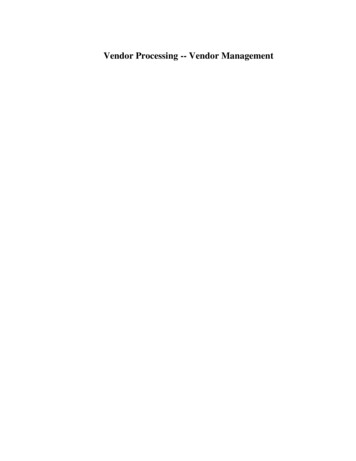
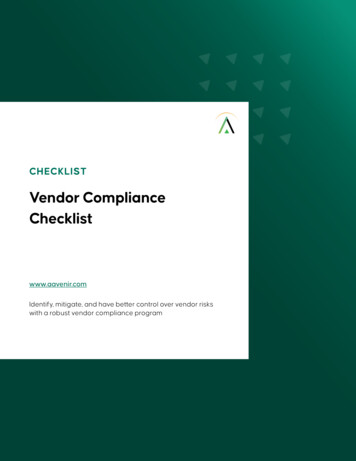

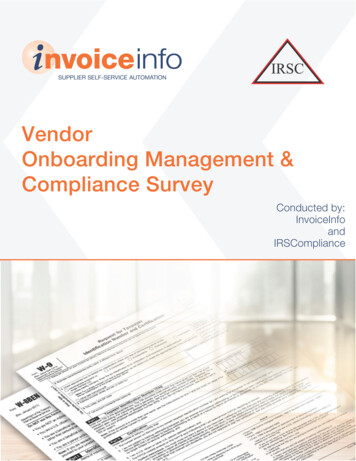
![Vendor Managed Inventory Master.pptx [Read-Only]](/img/27/vmi-learning-seminar.jpg)

